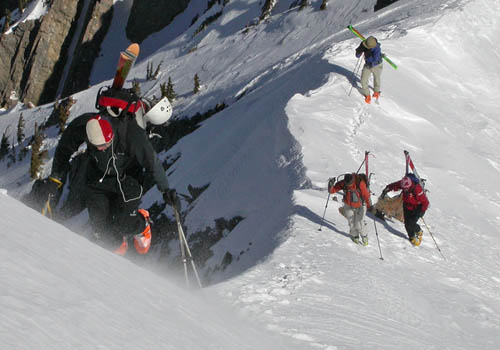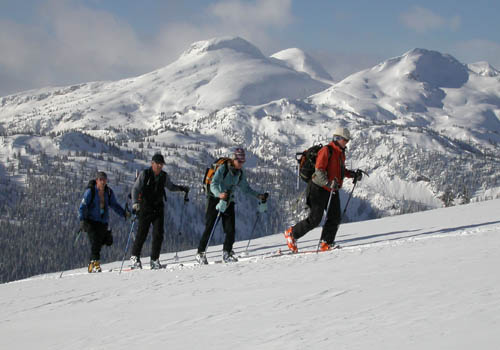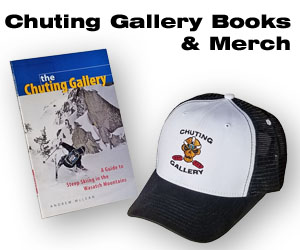Good Snow Hunting – Elevation
To go high, low or somewhere in between? That is the elevation question. Many of the backcountry huts I’ve been to are located right at tree line, which is ideal for keeping your elevation options open. If conditions are good, you can go up. If not, you have the option of skiing down in the trees.
Lower elevations tend to have warmer snow, less coverage and melt out earlier. But, they can also be more sheltered, have less avalanche danger and become supportable sooner. Because good quality snow at lower elevations is fleeting, I try to ski it first and save the upper elevations for later.
Upper elevations are colder, and thus have lighter, drier snow, but are also more exposed to wind, so they can get blown out. Often times “good skiing” at upper elevations means looking for supportable windboard or corn snow. The best time to look for upper elevation powder is after a storm which has had little to no wind (a semi rare occurrence), or after a long dry spell of cold, clear nights when recrystalized powder might form.

Upper elevations often get blown out, which is great for carveable foam, but not so good for powder hunting.
Mid elevations often have the best snow quality as they are sheltered from the ridgetop winds, yet still high enough to be cold. Trees will further shelter the snow from direct sunlight, which can help preserve the fluff for days after the last storm. The downside of mid-elevations is that it can often be hard to find suitable skiing terrain, which is why good mid-elevation, sheltered tree skiing zones are coveted secrets–you can almost always find good snow there.
________________________________
Help support StraightChuter.com and figure out exactly where you are with a Garmin eTrex Legend GPS from Backcountry.com. Click on the photo below…

Category: Tips & Technique











By upper elevations you are referring to above treeline I assume. The elevation game makes you realize how nice it is to have a good snow year at low elevations. The worst is when it rains down low and not only takes away that option for skiing but also makes it harder/longer to make your way out of the higher elevations.
What? No mention of low elevation scrub-oak? Some of my favorite ski hills require approach and descent through this God-forsaken excuse for flora. It might just be the next big thing in extreme skiing: high speed, srub-oak-thrashing descents. If your expensive softshells aren’t shredded, your face certianly will be. A friend once had his eye-ball nearly plucked when snagged by the stuff. (Always wear glasses or goggles, even after dark.)
“The downside of mid-elevations is that it can often be hard to find suitable skiing terrain, which is why good mid-elevation, sheltered tree skiing zones are coveted secrets–you can almost always find good snow there”
I asked you about a spot you skied a few posts ago and you replied that it was “in the wasatch moutains.” Let me guess; Mid-elevation?
OMR – If you come down the south face of Lone Peak – AVOID FORT CANYON.
OMR – Scrub oak is such a treat that it deserves an entire posting devoted to it. There is really nothing like the feeling of having your clothes torn, face cut and pack snagged through a forest of scrub oak. Hmmmmm, good!
Hi Rob – most likely, but I think I’ve forgotten already. ;)